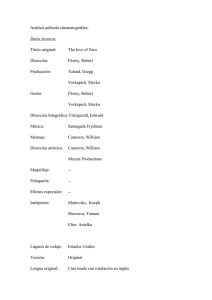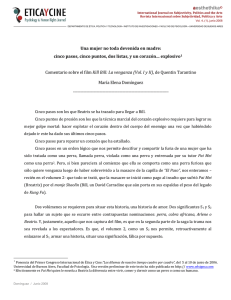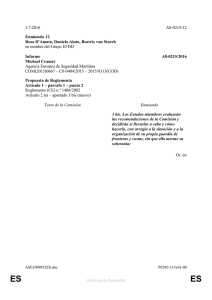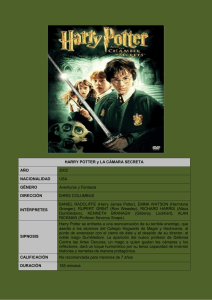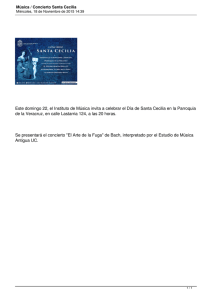lucía pizzani - Cecilia Brunson Projects
Anuncio
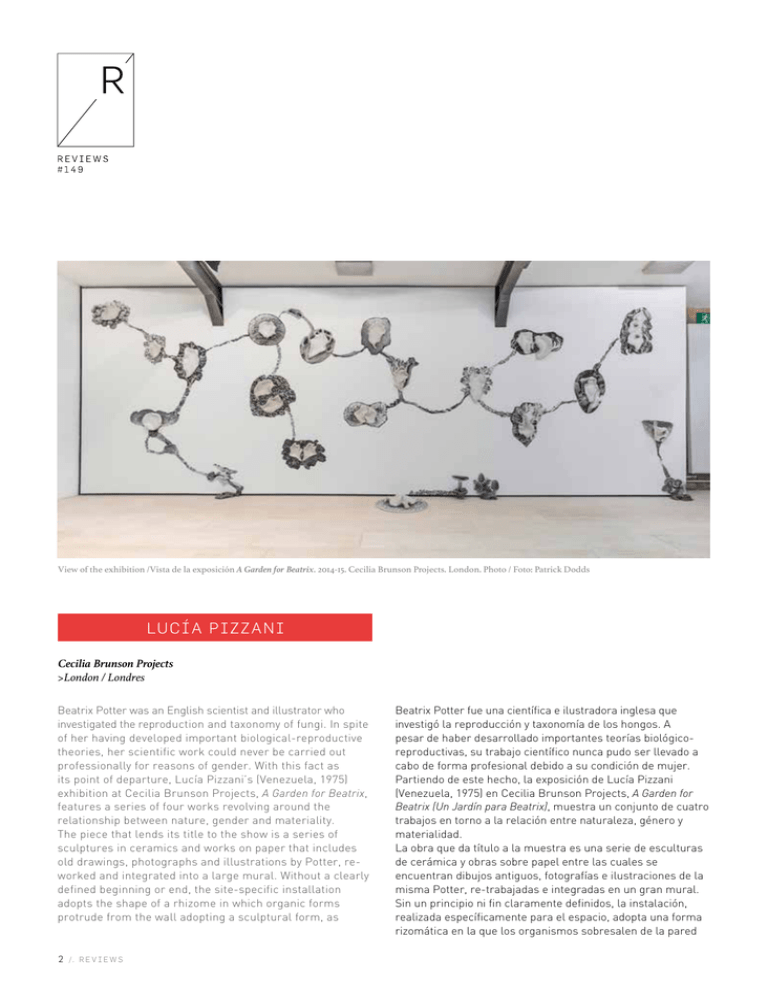
View of the exhibition /Vista de la exposición A Garden for Beatrix. 2014-15. Cecilia Brunson Projects. London. Photo / Foto: Patrick Dodds LUCÍA P IZ Z AN I Cecilia Brunson Projects >London / Londres Beatrix Potter was an English scientist and illustrator who investigated the reproduction and taxonomy of fungi. In spite of her having developed important biological-reproductive theories, her scientific work could never be carried out professionally for reasons of gender. With this fact as its point of departure, Lucía Pizzani’s (Venezuela, 1975) exhibition at Cecilia Brunson Projects, A Garden for Beatrix, features a series of four works revolving around the relationship between nature, gender and materiality. The piece that lends its title to the show is a series of sculptures in ceramics and works on paper that includes old drawings, photographs and illustrations by Potter, reworked and integrated into a large mural. Without a clearly defined beginning or end, the site-specific installation adopts the shape of a rhizome in which organic forms protrude from the wall adopting a sculptural form, as 2 /. R E V I E W S Beatrix Potter fue una científica e ilustradora inglesa que investigó la reproducción y taxonomía de los hongos. A pesar de haber desarrollado importantes teorías biológicoreproductivas, su trabajo científico nunca pudo ser llevado a cabo de forma profesional debido a su condición de mujer. Partiendo de este hecho, la exposición de Lucía Pizzani (Venezuela, 1975) en Cecilia Brunson Projects, A Garden for Beatrix (Un Jardín para Beatrix), muestra un conjunto de cuatro trabajos en torno a la relación entre naturaleza, género y materialidad. La obra que da título a la muestra es una serie de esculturas de cerámica y obras sobre papel entre las cuales se encuentran dibujos antiguos, fotografías e ilustraciones de la misma Potter, re-trabajadas e integradas en un gran mural. Sin un principio ni fin claramente definidos, la instalación, realizada específicamente para el espacio, adopta una forma rizomática en la que los organismos sobresalen de la pared if they had a life of their own. It is an immaculate work, perfectly mounted, precise and highly evocative. Bearing as its title the categorization included in the archive from which the artist has drawn the images, Unidentified Women is an ensemble of photographs projected on the wall that features portraits of late 19th century women which have become covered by fungi with the passage of time. This only reiterates the anonymity of the protagonists, transforming their silhouettes into phantasmagorical abstract forms. With an unhurried rhythm, the images go by in silence, although they are flanked by two pairs of headphones through which visitors may listen to fragments of media news from different countries related to “unidentified women.” In a subtle but direct way, the story is brought to the present to make us reconsider the obligation to remember. Based on the collodion wet-plate photographic technique, invented at the end of the 19th century and currently almost obsolete, Sagrario is the last series in the show. An ensemble of photographic plates depict a number of settings in which the protagonists are a series of bodies made of printed fabrics with a background of plants, which might well appear to be still life paintings. Beyond the stillness and the scenography, the shapes of these life forms evoke movement and mutation, as if something were about to emerge from inside these organisms. The exhibition A Garden for Beatrix pays a beautiful tribute to Beatrix Potter and to all the women that went unnoticed through the annals of history. Making good use of the intimacy provided by the exhibition space, located in curator Cecilia Brunson´s house, Lucía has succeeded in generating a poetic and welcoming environment where not only there is room for the political, but whose four walls emanate it. adoptando una forma escultórica como si tuvieran vida propia. Es un trabajo inmaculado, perfectamente montado, preciso y muy evocador. Titulada con la misma categorización del archivo del que la artista ha sacado las imágenes; Unidentified Women (Mujeres no identificadas) es un conjunto de fotografías proyectadas en pared que muestra retratos de mujeres de finales del S.XIX, que, con el paso del tiempo, han sido cubiertas de hongos. Esto no hace sino reiterar el anonimato de las protagonistas, convirtiendo sus siluetas en formas fantasmagóricas abstractas. Con un ritmo pausado, las imágenes pasan en silencio aunque a su lado hay dos pares de audífonos en los cuales se narran fragmentos de noticias de medios de comunicación de diferentes países sobre “mujeres no identificadas”. De forma sutil pero directa, la historia es traída al presente para hacernos recapacitar sobre la obligación al recuerdo. Haciendo uso de la técnica fotográfica del colodión húmedo, inventada a finales del S.XIX y hoy casi obsoleta, Sagrario es la última de las series en la muestra. Un conjunto de placas fotográficas retratan unos escenarios en los que los protagonistas son unos cuerpos de tela estampada con plantas de fondo que bien podrían parecer bodegones pictóricos. Más allá de la quietud y la escenografía, las formas de estos organismos evocan movimiento y mutación; como si algo estuviera a punto de emerger de su interior. La exposición A Garden for Beatrix (Un Jardín para Beatrix) rinde un bello homenaje a Beatrix Potter y a todas las mujeres que pasaron desapercibidas por los anales de la historia. Haciendo uso de la intimidad que provee el espacio, situado en casa de la curadora Cecilia Brunson, Lucía ha sabido generar un ambiente poético y acogedor donde no sólo hay cabida para lo político, sino que lo emana por sus cuatro paredes. Alba Colomo YOAN CAP OT E Jack Shainman >New York Yoan Capote’s Collective Unconscious inhabits binary spaces. Two galleries of work explore two seemingly contradictory themes—physical and mental suppression, and human resilience. Capote chooses to explore these themes by using historically laden signifiers such as photographs of groups of protestors and handcuffs, as well as by using everyday easily recognizable materials such as plastic laminate cutting boards and door hinges to create his sculptural installations. These familiar materials allude to the presence of a shared memory and suggest that there exists a collective understanding, however Capote (Cuba, 1977) offers no resolute narrative from which to actualize any specific truth. Instead, by situating objects in both congruous as well as oppositional relationships La muestra de Yoan Capote Collective Unconscious (Inconsciente Colectivo) habita espacios binarios. Dos galerías presentan obras que exploran dos temas aparentemente contradictorios – la represión física y mental, y la resiliencia humana. Capote ha elegido explorar estos temas utilizando significantes con una carga histórica, tales como fotografías de grupos de manifestantes y de esposas, así como empleando materiales de uso cotidiano fácilmente reconocibles como tablas para picar de laminado plástico y bisagras para puertas, en la creación de sus instalaciones escultóricas. Estos materiales familiares aluden a la presencia de una memoria compartida y sugieren la existencia de una comprensión colectiva; no obstante, Capote (Cuba, 1977) R E V I E W S /. 3
